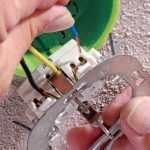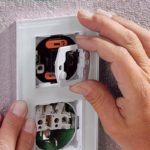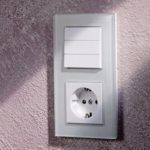For an aesthetic interior, convenience for owners and saving space, a socket with a switch in one case is used. The design combining the power point and lighting control also ensures a rational power supply in the home or office. It is easy to install with your own hands.
- Paired devices
- Advantages and disadvantages
- Features of combined products
- How to choose a socket with a switch
- How to connect an outlet and switch
- Installing a one-key socket
- Installing a two-key unit
- Connecting a socket and a switch from a two-wire wire
- Connecting a socket with a switch in one block
- How to connect the double switch and the outlet to the mains
- Connection diagram of a socket and a switch with three buttons
- Features of connecting a double socket in a residential area
- Non-standard application
Paired devices
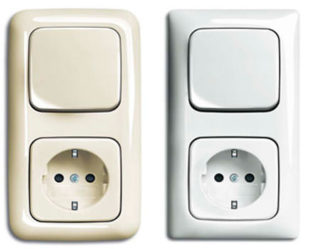
Combination switches were not familiar to electricians until the mid-20th century. One-button switch was an actual way to control light sources. Two identical products were placed side by side. A little later, manufacturers released two-button switches for controlling individual groups of chandelier lamps.
A three-button switch, combined with an outlet, appeared on the territory of the Russian Federation during the development of the construction of panel houses. The devices were designed to turn on the lights in the kitchen, washroom and bathroom.
The socket was installed in the bathroom for the convenience of using a hairdryer, electric razor. After the popularization of washing machines, they began to be connected to a combi-device with or without grounding.
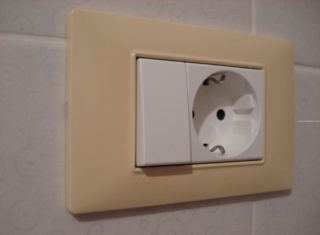
In modern high-rise buildings, double structures are used for kitchens, bathrooms and living quarters. The reason lies in European standards, according to which:
- switches are located at a height of 160 cm from the floor;
- sockets are brought out to a height of 30-90 cm from the floor.
This connection allows the switches to be positioned at eye level for ease of use and furniture placement. Removing the socket provides a comfortable switch-off of the lighting without changing the position of the hand.
Low-lying outlet groups in the bedroom are convenient for masking wires. In the kitchen, they are placed above the work table, serve to illuminate the cooking area and connect household appliances. In studio apartments, general and local light is used as a way of zoning space.
The combined devices are convenient for using multiple electrical devices.
Advantages and disadvantages
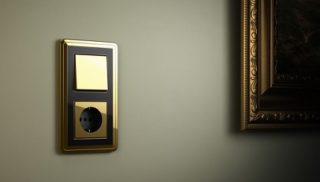
The demand for combined devices is driven not only by the desire to increase the number of outlets. Combined modifications have several advantages:
- reducing the number of conductors - you will need two cables from the shield and wires in an amount equal to the switch keys;
- reducing the time for organizing the wiring - all conductors are in a common strobe;
- no need for additional flashing;
- ease of installation;
- ease of lighting control and use of household appliances.
The disadvantages of designs include:
- high cost in comparison with single elements;
- replacement of the entire block in the event of a breakdown of one unit;
- increased load on the power wires;
- limited location.
Heavy-duty plugs and cords make the switch difficult to use.
Features of combined products
The paired modules are suitable for installation on wood, stone, plasterboard and concrete surfaces. They are distinguished by their aesthetic appearance, ergonomics and are installed with a minimum number of installation channels.
Models can be built into the wall or located on its surface. They are suitable for indoor use or are equipped with a moisture-resistant enclosure for outdoor installation. A special cover prevents moisture and dust from reaching the inside of the case and to the contacts. This solution is relevant if the bathroom is equipped with an interlocked modification.
How to choose a socket with a switch
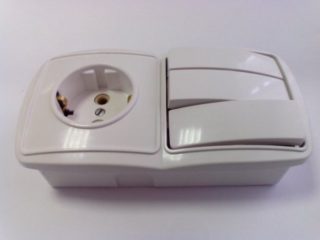
When choosing the right device, you should pay attention to several factors:
- compatibility with the technical characteristics and features of the power line;
- compliance with the design of the room;
- functionality in terms of the power of the connected equipment;
- the number of buttons and sockets in one block;
- installation features.
Manufacturers produce several models:
- double version - consists of a switch and an ungrounded socket;
- indoor unit with a switch and a grounded socket, the key is with a light indicator;
- accessories for outdoor installation - the socket and the button are hidden under a cover with protection class IP 54.
On sale there are options with various combinations of keys, switches, socket groups. The outer part of the case can be removed - the triple device is suitable for the system socket + switch + slot or USB port.
The average cost of a simple device is 200 rubles. A sample for Euro wiring with two buttons costs about 300 rubles. and is suitable for a total power of 3.5 kW. Waterproof modifications will cost about 450 rubles, and a power unit for three sockets and a one-key switch - 1000 rubles.
How to connect an outlet and switch
Most often, a socket + one-button switch and an outlet block + two-button switch are used together.
Installing a one-key socket
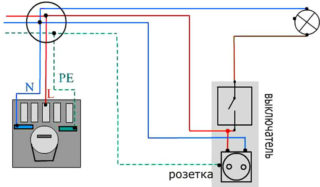
The connection diagram provides for the laying of a three-core wire from the junction box to the unit:
- In the junction box, the neutral of the power supply is connected to the neutral conductors of the lighting and the socket.
- In the switchboard, the mains phase is connected to the socket phase.
- In the unit itself, the resulting phase and neutral are connected to the contacts.
- The socket phase is bridged onto the switch input contact.
- The wire connected to the lighting phase in the switchbox is integrated with the output contact of the switch.
A grounded outlet must be connected to a four-wire wire.
Installing a two-key unit
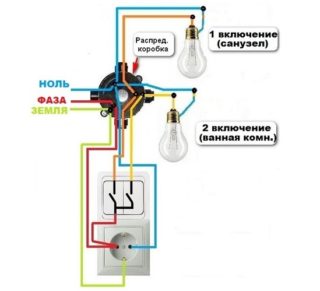
A socket with a two-button switch in one common housing is mounted as follows:
- The phase of the socket must be connected to the input contact of the switch with a jumper.
- Connect the phase cables to the output contacts of the switch.
- Take the conductors into the switch box and connect them to the phase conductors of the lamp holders.
- Throw the zero of the power supply on the zero conductors directed to the outlet and the lamps from the junction box.
Correct installation is only possible if the following recommendations are observed:
- prepare tools - a drill with a drill column, screwdrivers, pliers and wire cutters;
- use tools with insulated handles;
- overhead type of paired devices excludes wall chasing;
- waterproof blocks are suitable for installation in bathrooms and toilets.
The PUE rules indicate the need to turn off the electricity in the entire apartment before installing electrical equipment.
Connecting a socket and a switch from a two-wire wire
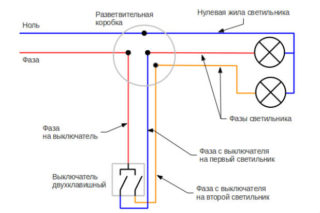
The simplest diagram assumes a clear sequence of wires leading from the switchgear to the device. The connection is carried out as follows:
- Selecting a site where the indoor or outdoor unit will be located.
- Surface marking.
- Finding the phase in the switchboard and turning off the electricity in the room.
- Throwing a phase on the switch. You will need to strip the ends of the corresponding wires, twist them and cover them with insulating material.
- Roll up unused wires into a ring and cover with insulation.
The use of the scheme is justified only in cases of rare use of the network socket. The combined device works on the principle of supplying a phase to the power point by turning on the switch.
Use such a system to connect a boiler without a shutdown button.
Connecting a socket with a switch in one block
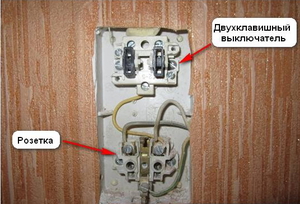
Structural elements are operated together or separately. To install the device you will need:
- Lead the phase and zero cable from the main board to the distribution box.
- Place in the junction box 2 cables from the luminaires and 3 wires from the unit.
- Throw the phase conductor from the shield onto the outlet.
- Connect the neutral of the mains to the zero of the unit.
- Twist together the phase conductors connecting the cartridge to the switch and insulate them.
- Connect the ground line from the lead-in cable.
With this method, the socket functions separately from the lighting, but the devices can be turned on at the same time.
Use a jumper to create a connection between terminal and socket.
How to connect the double switch and the outlet to the mains
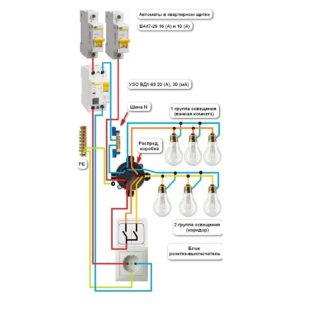
A two-button switch, combined with an outlet, is usually installed in a wall partition between the doors of the bathroom and the bathroom. This allows users to control lighting fixtures and turn on household appliances.
The device should be connected using 5 cables connecting the unit to the junction box:
- Connect a couple of free cores to switching contacts.
- Apply a phase to the breaker using a jumper.
- Apply a phase to the bathroom and toilet light through the commutation contacts.
- Twist the free core wires with the phase supply cables through the commutator in the distribution box.
- Form a coupling between the neutral wire and grounding with a twist (bare ends), bring them to the socket.
Choose an outdoor unit or bathroom system with a moisture-resistant enclosure and curtain covers.
Wiring diagram for a socket and a switch with three buttons
The configuration of the unit saves the energy used, since it will be the control element for several lighting fixtures in the same room:
- main lamps;
- decorative lighting;
- secondary light sources.
Due to this, in case of insufficient lighting, it is possible not to connect the devices to the network, but to activate them by pressing a key. The brightness of the lighting is also adjustable.
The wiring diagram is almost identical to the connection of one-key or two-key models. In this case, zero is the blue wire, and the phase is black or red. The neutral cable is thrown onto the outlet.
Features of connecting a double socket in a residential area
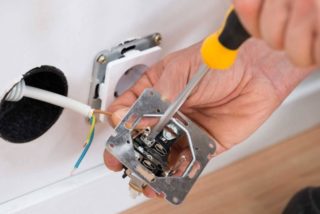
If there are several household appliances, it is worth installing a unit for 2 or more electric outlets with parallel connection. Before starting the installation, jumpers are created from 3 cables and brought to the connection point. The work is carried out according to the following algorithm:
- Disassembly of each outlet.
- Cleaning of box jumpers, conductors, power supply cable.
- Connecting the first outlet to the input cable.
- Installation of an element in a mounting box.
- Parallel connection of cables according to color and installation of subsequent power points.
Leave the cable taken out from the junction box with a margin.
Non-standard application
Some masters advise using a single-key with an outlet instead of a standard outlet - bring the phase through a switch. This method is convenient for equipment without a shutdown button or a quick disconnection of the equipment.
The disadvantage of the scheme is compatibility only with low-power consumers, which in practice almost does not happen. None of the contacts are rated for high current, so the wiring heats up, melts and causes a fire.
The idea of combining an on / off switch and an outlet came up recently, but the devices quickly became popular for convenience and functionality reasons. With proper adherence to the schemes, combined devices will become an excellent interior solution, zoning the space, and increasing the number of power points.


